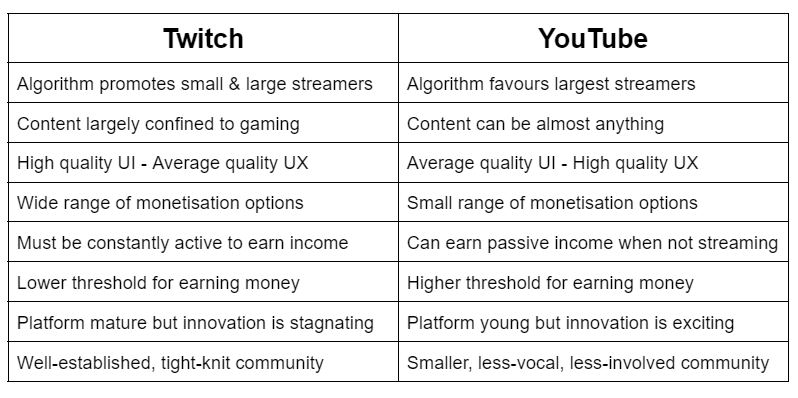Whether you’re just starting out as a streamer, or you’ve been in the game for a long time but need a fresh perspective, you’re here because you want the answer to one simple question: Which is better for streaming, Twitch or YouTube?
There’s been a huge amount of debate around this seemingly straightforward question, with drama unfolding on both sides of the spectrum. Some of Twitch’s highest-earning streamers, like Dr Disrespect, have left the platform in favour of YouTube, whilst YouTube bans and a biassed algorithm make it difficult for new channels to find a foothold.
I’m a gamer, a tech-writer, and a qualified researcher who’s coming at this topic without allegiance to either side. I’ve studied the issue – listening to arguments for and against both YouTube and Twitch – and now I’m going to break down for you exactly how each platform performs across a range of key metrics.
YouTube Gaming vs Twitch Streaming: Pros & Cons Breakdown

Getting Discovered and Building a Following
Why do any of us stream? To be watched. Plain and simple.The first thing I want to discuss is how easy it is to get discovered on Twitch versus on YouTube, and how easy it is to then build a following.
There are a few things to consider here. YouTube has been around for longer, and as such has a much larger base of active monthly users than Twitch does (2.46 billion more monthly users, to be precise). By the same token, all 140 million of Twitch’s active monthly viewers visit the platform to tune into live streams, whereas only a small fraction of YouTube’s users do.
Then, there’s the algorithm.
YouTube does a pretty poor job of promoting livestreams to channel subscribers, let alone to random viewers. Even when it does push livestreams (above pre-produced video content), it generally shows strong bias toward only the very largest channels on the platform.
In contrast, Twitch – though not perfect – does a much better job at shining the spotlight on small streamers just starting out (especially if they’re playing niche games). The search function on Twitch is also much more user-friendly, ensuring that users can easily navigate the site and stumble across small channels producing interesting content.
Verdict: If you’re just starting out, Twitch makes it much easier to be discovered and start to build a following of genuine fans. YouTube isn’t great for beginners, but has a much larger overall usership, meaning that for already well-established streamers, it can open new doors.
Type of Content
‘Streaming’ is often thought to be synonymous with ‘gaming’, but as recent Twitch scandals have shown, this is not always the case. Streaming today can feature just about any type of content imaginable. There’s ASMR streamers, live streams of people sleeping or eating, travel vlog streamers, reaction video streamers, and so much more.
Twitch has earned its reputation as a platform almost exclusively for people to stream whilst playing their favourite games. On the other hand, YouTube’s popularity stems from the fact that the site hosts videos of literally all kinds.
Furthermore, because Twitch focuses on live streams only, there is no ‘evergreen’ quality to content found on the platform, whereas YouTube is all about evergreen videos (videos which will be accessible and retain value over time).
Verdict: If you’re a streamer who wants to make a name for themselves in a non-gaming niche (or a gamer who wants to diversify their content), then YouTube may well be the better choice for your channel, since users already know to go to that platform to search for niche interests. If you’re solely a gamer, however, then Twitch remains the go-to platform for viewers interested in finding new streamers to watch.
User Interface (UX and UI)
As a streamer, you’ve got to be aware of how the experience (UX) and interface (UI) is for your audience. It’s your job (or hobby) to give them an accessible, enjoyable, and engaging stream, and the UX and UI of the platform you’re using are directly responsible for setting those bars.
Let’s start with User Experience (UX). Surprisingly, despite being designed for streaming, Twitch falls a little short in this category. You’re only able to stream up to 1080p at 60fps, whereas via YouTube you could hit 4K streaming quality, provided you had the right bandwidth.
Additionally, YouTube offers the user the ability to pause and rewind live streams whilst they’re happening, whilst you have to wait until the stream is over on Twitch before you can rewatch any of it.
When it comes to User Interface (UI), however, I’m inclined to say that Twitch just edges past YouTube. Despite YT’s interface having the benefit of familiarity (for 2.6 billion people around the globe), the YouTube Gaming side of the site is confused, hard to navigate, and though they’re adding new features which mimic Twitch, it’s still got a ways to go before it offers the same viewer-streamer interactivity which Twitch does.
Verdict: For stream quality and functionality, YouTube is surprisingly superior to Twitch (albeit just); whereas in terms of the overall interface and relationship fostered between viewer and streamer, Twitch takes the trophy. In all? The two platforms are pretty equal in terms of UI and UX.
Making Money as a Streamer
Now for the section most of you came here for. Which platform is better for streamers who want to make money? Let’s take a look.
Monetisation Options
There are lots of different ways you can make money as a streamer:
- Sponsorship deals with brands
- Featured ads
- Affiliate marketing links
- GamePlay sessions
- Product placement
- Subs and Bits (Twitch only)
- Fan donations
What’s interesting, however, is that not all of these avenues are open to you on all streaming platforms. Let’s break that down.
Both YouTube and Twitch allow you to make money by featuring ads before (“pre-stream”) and during (“mid-stream”) your session. You can also host affiliate marketing links on both platforms, and earn revenue via sponsorship deals with brands – which companies like Mindfuture make easy to find – as well as via product placement.
If you like, you can even host a link to an external donation page on both YouTube Gaming and Twitch.
However, only Twitch allows streamers to earn via subscriptions to their channel, and with ‘Bits’ (Twitch currency which viewers can elect to pay you with).
Verdict: In short, Twitch offers streamers a wider variety of ways to monetize their streaming.
Passive vs Active Income
One of the biggest sticking points I’ve come across in the whole “is YouTube or Twitch better for streamers” debate is to do with ‘Passive’ versus ‘Active’ income.
Passive income means that you’re able to bring in money even when not actively working.
Active income means that in order to make money you have to be actively working.
For streamers, typically you would have to be streaming in order to make money from your sponsorship deals, ads and viewer subscriptions/donations. Thus, streaming would be categorised as an ‘active income’ job. Certainly, this is the only way to make money on Twitch – if you ain’t streaming, you ain’t earning cash!
Where things get a little interesting is that on YouTube, there are actually lots of ways you can create a passive income stream for yourself. As streamer Eljay explains it, due to the ‘evergreen’ nature of YouTube videos, stream clips, and the diversity of content you can post as a streamer through your YouTube Gaming channel, you can be making money from your library of historic videos even when on a break from streaming (e.g. a holiday, or whilst ill). Whereas, you cannot do this on Twitch.
Verdict: If you’re a gamer who’s happy to stream regularly and stick to a strict schedule, then Twitch is still a fantastic platform for monetising your work. On the other hand, if you want to create a passive income stream by producing evergreen content in addition to your live streams, then YouTube is the only platform which will allow you to do that.
Monetisation Threshold
The final element to consider in which platform – Twitch or YouTube – is best for making money as a streamer, is the threshold at which you can actually start pulling-in revenue.
In short, you don’t make money simply by streaming. You have to first grow enough of a following for it to be profitable for your host platform to start paying you. (That is, unless you sign-up for sponsorship via a streamer-friendly marketing agency.)
The threshold at which you can begin making revenue is different for Twitch users and YouTube users.
To become a Twitch Affiliate, you must have an average concurrent viewership (CCV) of at least 3, at least 50 followers, and at least 500 minutes of streaming over 7 days during the last month. To become a Twitch Partner (from whom Twitch takes a smaller cut of the profits), you must have on average at least 75 CCVs and 25 ‘watch hours’ over 12 days in the last month.
To become a YouTube Partner, you must have at least 1,000 subscribers and have accrued a whopping 4,000 watch hours over 12 months. For most streamers, this is simply unattainable. Compared to requiring a minimum of just 3 concurrent viewers and 8-ish hours of streaming a month to be a Twitch Affiliate, YouTube Partnership is a pipe dream for all but the most successful few.
Verdict: It’s hard to make money as a streamer. Period. Nevertheless, Twitch is undeniably better equipped for even the smallest channels to monetise their streams. In contrast, making money on YouTube is only really possible if you already have a massive audience which will follow you there.
Which is better for streamers, Twitch or YouTube? – The Answer!
Both Twitch and YouTube offer flawed, imperfect services to viewers and streamers. At the same time, without them we wouldn’t have the game streaming culture we do.
When it comes to which is better for streamers, the answer to me seems pretty obvious: a combination of both is best!
Unless you are already a hugely-successful streamer, then YouTube is a hard platform on which to find a following, get recognised, or make money. Twitch, on the other hand, lends itself to the smaller streamer, and has monetisation options almost from the get-go.
YouTube Gaming – despite its flaws – is growing at a rapid rate, has a much larger user base, and a more diverse portfolio of content. Thus, over time, you could theoretically ride that wave to greater success than you would ever achieve through Twitch alone.
If you want my opinion: Stream on Twitch (whether you’re a gamer or not), but upload clips from your streams – as well as related evergreen content – to YouTube at the same time. This way, you can enjoy the benefits of both platforms. If, in time, you acquire a massive following on Twitch, then (and only then) you could indeed consider making the full-time move to streaming on YouTube Gaming instead. Until that point, however, a mixture of both is best.
At the end of the day, remember to enjoy whatever you choose to do. We all got into gaming because it’s fun, and it should remain that way. Good luck!
Want more news from the Tech world for Gaming Peripherals to Hardware Click Here








You must be logged in to post a comment.